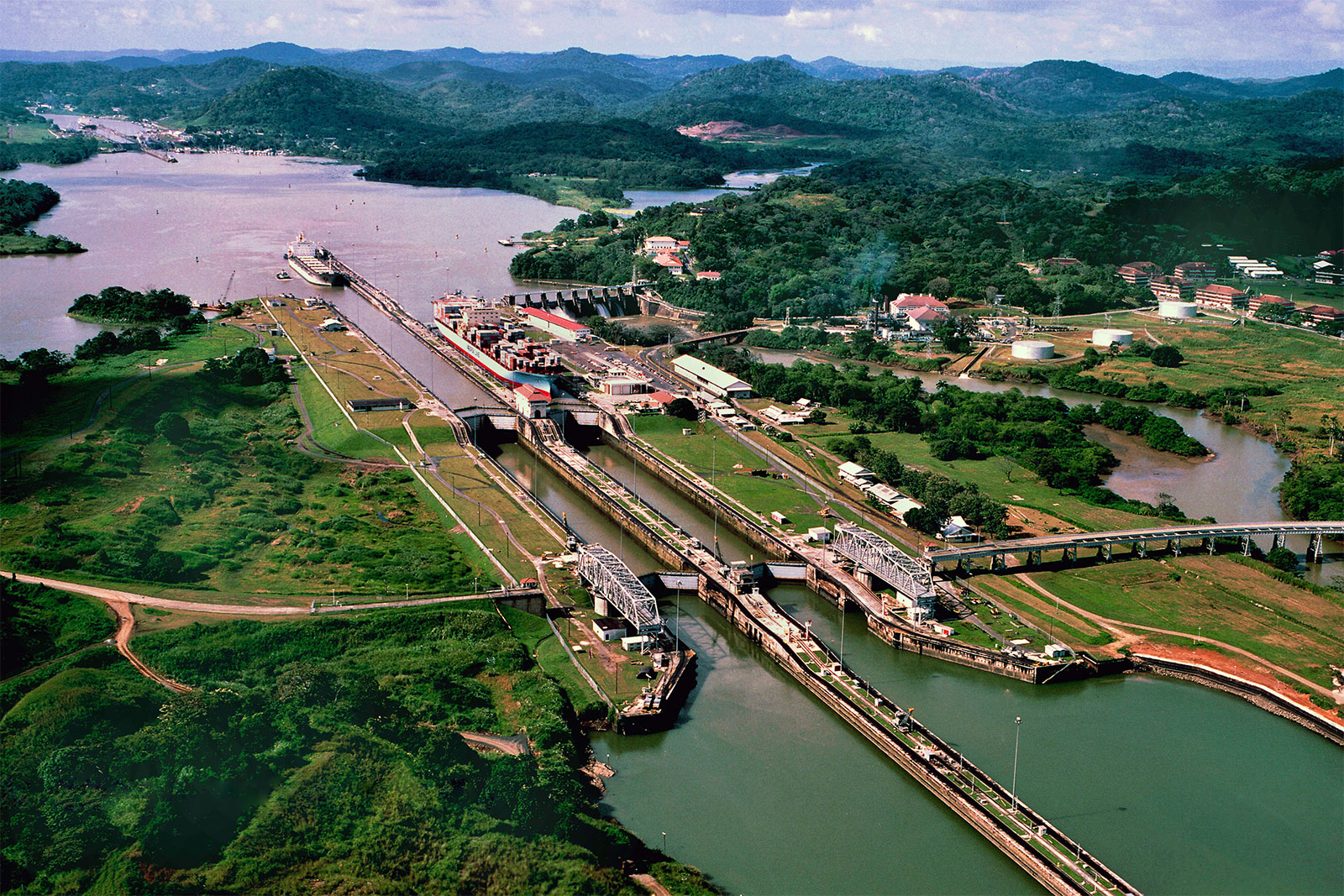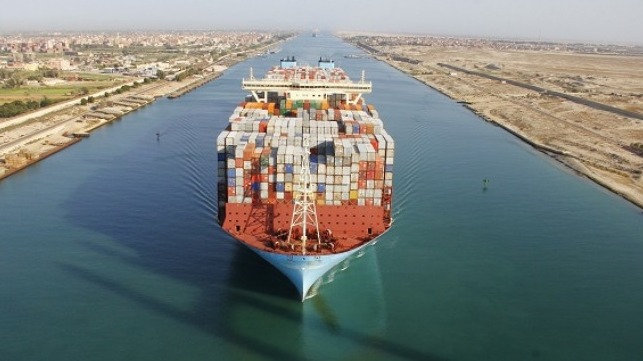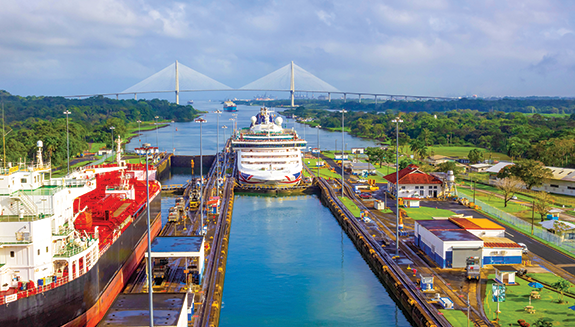You’re familiar with the Panama and Suez Canals, but have you explored the lesser-known yet equally impressive Amsterdam-Rhine Canal? This waterway is a crucial link in Europe, connecting major ports and industrial hubs. As you ponder the impact of global trade on these canals, consider how the Caledonian Canal in Scotland weaves through stunning landscapes, blending nature and commerce seamlessly. Each of these 10 famous shipping canals tells a unique story of human innovation and perseverance, shaping our modern world in unexpected ways.
Panama Canal

The Panama Canal, an essential waterway connecting the Atlantic and Pacific Oceans, stands as a remarkable feat of engineering and ingenuity. This iconic canal has played a significant role in Panama’s history, shaping its economy and trade dynamics.
The canal’s construction in the early 20th century not only revolutionized global maritime trade but also transformed Panama into a key player in international commerce.
Panama’s diverse wildlife and unique geography further enhance the allure of the canal, attracting tourists from around the world. The blending of indigenous traditions with Spanish influences has shaped Panama’s rich culture, making it a vibrant and colorful destination for visitors.
From an engineering perspective, the Panama Canal represents a monumental achievement, overcoming the challenging terrain to create an essential link between the oceans.
Its strategic location has made it a linchpin in global trade routes, facilitating the movement of goods between East and West.
Suez Canal

Connecting the Mediterranean Sea to the Red Sea, the Suez Canal serves as an indispensable maritime route that greatly impacts global trade and shipping operations. The history of the Suez Canal dates back to its construction in the mid-19th century, revolutionizing trade by providing a shortcut between Europe and Asia.
The canal plays a pivotal role in the economy of Egypt, generating significant revenue from tolls paid by ships passing through.
In terms of engineering, the Suez Canal showcases remarkable feats of human ingenuity, overcoming geographical challenges to create a navigable waterway. Its strategic location at the crossroads of Africa, Asia, and Europe makes it a fundamental hub for international trade, facilitating the transportation of goods between major markets.
Over the years, the Suez Canal has undergone expansions and enhancements to accommodate larger vessels and increase traffic capacity, further solidifying its importance in global maritime navigation.
Its continued evolution reflects the enduring significance of this iconic waterway in shaping the movement of goods worldwide.
Kiel Canal
Positioned in Northern Germany, the Kiel Canal, also known as the Nord-Ostsee Kanal, serves as an important waterway connecting the North Sea to the Baltic Sea.
The history of the Kiel Canal dates back to the late 19th century, when it was constructed to provide a shorter route for ships traveling between the two seas, avoiding the longer and more treacherous journey around the Jutland Peninsula.
The canal’s engineering marvels include its impressive locks that facilitate the passage of vessels of various sizes, making it an essential link for international trade and maritime transportation.
Kiel, the city at the canal’s eastern entrance, has flourished as a significant maritime hub due to the canal’s strategic location.
The canal not only plays an important role in boosting the region’s economy but also offers a picturesque route for leisure cruises and maritime enthusiasts.
The blend of history, engineering ingenuity, and economic importance makes the Kiel Canal a remarkable feat of human achievement that continues to shape global shipping routes.
Corinth Canal
Nestled in southern Greece, the Corinth Canal stands as a remarkable feat of engineering that has long captured the imagination of maritime enthusiasts and historians alike.
The history of Corinth dates back to ancient times, making it a significant location for trade and travel. The engineering marvel of the Corinth Canal showcases human ingenuity and determination, as it cuts through the Isthmus of Corinth, connecting the Gulf of Corinth with the Saronic Gulf in the Aegean Sea.
- Ancient Roots: Explore the rich history of Corinth, a city that has played a significant role in the development of Greece.
- Engineering Wonders: Investigate the intricate details of the construction of the Corinth Canal and the challenges faced by engineers.
- Modern Significance: Learn about how the Corinth Canal continues to be an essential waterway for trade and tourism, attracting visitors from around the world.
Welland Canal
The Welland Canal, an essential waterway in Ontario, Canada, serves as a significant link between Lake Ontario and Lake Erie. Its history dates back to the early 19th century when the first Welland Canal was constructed to bypass the Niagara Falls and facilitate transportation of goods between the Great Lakes.
The current Welland Canal, with its impressive system of locks, plays an important role in enabling ships to navigate the Niagara Escarpment and avoid the tumultuous waters of Niagara Falls.
The Welland Canal’s significance lies in its contribution to the economic development of the region by providing an indispensable connection for shipping and trade. It allows vessels to travel between the upper and lower Great Lakes, fostering commerce and supporting industries along its route.
The canal’s strategic location and efficient operation make it a key component of the St. Lawrence Seaway system, enhancing maritime transportation and facilitating international trade.
The Welland Canal stands as a monument to engineering ingenuity and remains an essential artery for maritime traffic in the heart of North America.
Grand Canal (China)
Running through several provinces in China, the Grand Canal is a historic waterway that plays an essential role in connecting the Yellow River and the Yangtze River.
The Grand Canal, with a history dating back over 2,500 years, stands out as one of the world’s oldest and longest man-made waterways.
Here’s why you should be intrigued:
- Cultural Marvel: Explore the rich history and culture surrounding the Grand Canal, reflecting the architectural and engineering prowess of ancient China.
- Trade Hub: Witness the bustling trade activities along the canal, which has been a significant route for transporting goods and connecting various regions in China.
- Scenic Beauty: Discover the picturesque landscapes and charming villages that line the Grand Canal, offering a serene and enchanting experience for tourists.
With its intricate construction, cultural significance, and breathtaking scenery, the Grand Canal stands as a representation of China’s engineering ingenuity and historical legacy.
Erie Canal
Connecting the Great Lakes with the Hudson River, the Erie Canal stands as a significant waterway in the history of the United States. Completed in 1825, the Erie Canal played an essential role in shaping the development of the nation. Its construction marked a remarkable engineering feat for its time, as it spanned 363 miles and included 83 locks to navigate the varied terrain.
The canal revolutionized transportation, greatly reducing the cost and time required to move goods between the East Coast and the Midwest. This led to a boom in commerce, with cities like Buffalo and Rochester flourishing as a result.
The Erie Canal’s impact extended beyond economics, also influencing the growth of tourism along its banks. Today, visitors can explore the canal’s historic locks, museums, and charming towns, experiencing a glimpse into the past.
In addition, the canal provides a habitat for diverse wildlife, with many species thriving in its waters and surrounding areas. Overall, the Erie Canal remains a symbol of American ingenuity and progress.
Manchester Ship Canal
Symbolizing industrial prowess and strategic innovation, the Manchester Ship Canal stands as a demonstration to human determination and progress. The canal, with its rich historical background and engineering marvels, has played a vital role in shaping regional connectivity and economic landscapes.
- Industrial Significance: The Manchester Ship Canal revolutionized inland waterway transportation, allowing goods to be transported directly to Manchester, bypassing the congested and expensive ports.
- Economic Impact: By greatly reducing transportation costs and enabling larger vessels to access Manchester, the canal spurred industrial growth, attracting businesses and boosting trade.
- Tourism Potential: Beyond its industrial roots, the canal has evolved into a cultural and recreational hub, attracting tourists with its historic warehouses, vibrant waterfront, and leisure activities.
The Manchester Ship Canal, while overcoming engineering challenges and considering environmental impacts, continues to guarantee navigation safety and foster local culture.
With ongoing developments enhancing its capabilities, the canal remains a beacon of innovation and progress in the shipping industry.
Amsterdam-Rhine Canal
Nestled within the heart of the Netherlands, the Amsterdam-Rhine Canal serves as an essential artery for regional trade and transportation. This important waterway plays a significant role in connecting the historic city of Amsterdam to the important Rhine River, facilitating the movement of goods and fostering economic growth in the region.
The history of Amsterdam is closely intertwined with its canals, including the Amsterdam-Rhine Canal. Constructed in the late 19th century, this canal was designed to improve transportation links between Amsterdam and the interior of the country, particularly the industrialized regions along the Rhine.
The construction of this canal not only boosted trade but also provided a strategic water route for goods coming in and out of Amsterdam, solidifying the city’s position as a key European trading hub.
Today, the Amsterdam-Rhine Canal continues to be an essential lifeline for the city, supporting the efficient movement of goods and enhancing Amsterdam’s reputation as a thriving center of commerce and industry.
Caledonian Canal
Stretching through the picturesque Scottish Highlands, the Caledonian Canal winds its way for 60 miles, cutting through stunning landscapes and connecting a network of lochs. The canal holds a rich tapestry of history and natural beauty for you to explore.
- Scottish History: Explore the past as you navigate through this historic waterway, originally designed by famed engineer Thomas Telford.
- Local Wildlife: Keep an eye out for the diverse wildlife that calls this canal home, from otters playing along the banks to majestic eagles soaring above.
- Recreational Activities: Embrace the outdoors with a variety of activities such as kayaking, fishing, or simply strolling along the towpaths.
The Caledonian Canal not only offers a glimpse into Scotland’s past but also plays a crucial role in the region’s economy and cultural heritage.
With its historical landmarks, environmental considerations, and tourism opportunities, this canal stands as a reflection of both human ingenuity and the beauty of nature.
Frequently Asked Questions
How Long Does It Take to Traverse the Panama Canal?
To traverse the Panama Canal, it typically takes around 8-10 hours. Panama Canal history dates back to the early 1900s. Transit time varies based on factors like vessel size and traffic, but it’s an engineering marvel worth experiencing.
What Are the Environmental Impacts of the Suez Canal?
When considering the environmental impacts of the Suez Canal, it’s essential to analyze canal pollution and habitat disruption. These factors have had significant consequences on the delicate ecosystems surrounding the canal, affecting biodiversity and water quality.
Can Tourists Visit the Kiel Canal?
Yes, tourists can visit the Kiel Canal. Enjoy engaging Canal sightseeing tours, witnessing the impressive locks and maritime traffic. Immerse yourself in the rich history of this crucial waterway, experiencing the bustling activity firsthand.
Are There Any Famous Shipwrecks in the Corinth Canal?
Yes, there are several famous shipwrecks in the Corinth Canal. The canal’s narrowness and strong currents have made it a challenging passage for ships throughout history, resulting in notable historical shipwrecks that still captivate maritime enthusiasts today.
How Many Locks Are There in the Welland Canal?
The Welland Canal, known for its crucial role in transiting ships, features eight locks. These locks, essential for managing water levels, facilitate the movement of vessels through the canal efficiently, showcasing impressive lock operation procedures.














